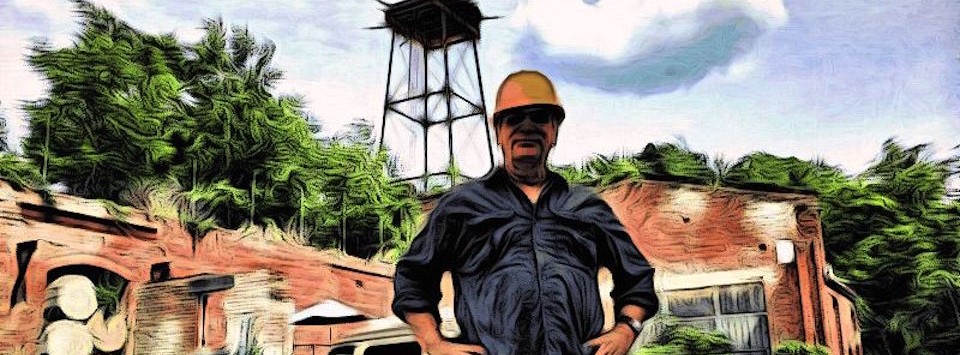A Really Old Wooden Ship
Or: IKEA is So Fourth Dynasty

Pick, Pack, and . . . Ship?
The world's oldest intact ship is, unsurprisingly, Egyptian. Specifically, it's the funeral barge for Khufu, also known as King Cheops, a pharaoh from the Fourth Dynasty of the Egyptian Old Kingdom. (You might know him as the guy who commissioned the Great Pyramid of Giza.)
Khufu's ship was discovered in 1954 by archaeologist Kamal el-Mallakh, who found the disassembled ship sealed into a pit in the bedrock near Giza. Aside from being disassembled, he found the ship in almost perfect condition, thanks to the ancient Egyptians having sealed it away in the desert bedrock.
The ship itself is built of Lebanon cedar, a material historically highly prized in shipbuilding, among other uses. It's mentioned several times in the Old Testament. Lebanon cedar is so embedded in the history of the region that it's the national emblem of Lebanon, and we see it on the national flag.
The cedar planks (before the ship was disassembled for storage) were held together with mortise and tenon joints, lashed together with cords of halfah grass fiber. (Only millennia later did we start using nails for shipbuilding.)
The ship was probably intended to serve as the pharaoh’s “solar barge,” a vessel to carry Khufu across the heavens with the sun god Ra. Interestingly, though watertight and seaworthy, there wasn't any rigging for sails or room for actual paddling. There was, however, evidence that it had been in the water at some point.
Remember I mentioned that it was found disassembled, and yet is considered the world's oldest intact ship? Despite being stored disassembled, it was painstakingly rebuilt by Ahmed Youssef Moustafa, an antiquities restorer. Took him years to learn the methods of ancient Egyptian boat construction, examining carved reliefs of boat construction in Egyptian tombs, other preserved boats, and the methods of modern Egyptian shipwrights. Moustafa’s reconstruction of the boat took 14 years in all.
The most important aspect of the reconstruction process? The parts of the ship were all laid out in a logical order when disassembled, and markings were put on each of the planks to show where they lined up.
Sounds familiar, doesn't it? The ancient Egyptians basically gave the pharaoh an IKEA boat for the afterlife.
The Yard Ramp Guy®: The Future of Industry
This week, my friend The Yard Ramp Guy takes a Ramp Rules-worthy look at this whole Industry 4.0 business and decides, to my relief, that humans remain important.
Check out his great insight HERE.

About Those Sickness Behaviors
Or: Get Better Soon

Feel Better
Quick question for you: Why does being sick give us unpleasant symptoms? Believe it or not, usually it's not the specific illness causing all those symptoms (though they certainly cause some.)
Fever would be the classic example here. Infections don't actually cause fevers. Instead, fevers are a defensive mechanism used by the body—most pathogens can only survive in fairly specific temperature ranges. Raising body temperatures is a good way to kill them off.
There's a more interesting series of reactions to infectious illness, however, known as “sickness behavior.” Fatigue, aches, chills, depression, irritability, nausea, and disinterest in socializing, among other symptoms, are all counted as sickness behavior. These symptoms show up again and again across countless diseases, and they're very seldom caused by the disease itself. (And they're not just in your head. The symptoms are physiologically very real.)
It turns out that there might actually be an evolutionary advantage to these symptoms. While they don't help kill invading pathogens directly, they do serve a specific purpose: they keep you away from other people.
If you're not interested in being around other people, you're less likely to spread illnesses to others, including those in your family group. Early humans or human ancestor species who lacked sickness behavior symptoms likely would have just wandered around and hung out with other, non-sick people, infecting them more frequently. Even if those individuals who lacked sickness behavior symptoms were better able to survive disease themselves (which there is no indication that they would’ve been), they'd still be less likely to pass on their genes.
This relates back to an idea known as evolutionary altruism—namely, that evolutionary survival and adaptation doesn't just happen on a personal level but also on a community level. Many behaviors that don't advantage the individual, or often even their family at all, end up being incredibly evolutionarily advantageous for the species. So, in the case of getting sick, the extra suffering is there to help others.
Moral of the story? Anyone who tries to claim that survival of the fittest means they don't have to be charitable and help others is full of it. Also, they don't understand natural selection. Survival of the fittest is actually a misinterpretation of Darwin's theory, but that's a story for another day.
The Yard Ramp Guy®: Yard Ramps & Structural Integrity
This week, my friend The Yard Ramp Guy defines "integrity" and combines it with international shipping routes in a way that pleases my roundabout sensibilities.
Check out his mighty fine blog HERE.

Lemmings Making Lemonade
About that r/K Selection

Not Really a Cliff-Diver
When you describe people as “behaving like lemmings,” most of us know what you mean (unless they're one of my grandchildren, who thought the word was “lemons”).
You're saying that the people are getting overwhelmed by mob mentality and preparing to launch themselves off a (let’s hope metaphorical) cliff because the rest of the crowd is doing likewise. Lemmings regularly commit mass suicide by jumping off cliffs, so it's a good metaphor, right?
Well, that's not exactly what lemmings do.
There are two main reproductive strategies among sexually reproductive organisms—the r-selection and the K-selection. Roughly speaking, a K-selection is one that favors fewer offspring, with more care dedicated to each one. Whales and eagles are classic examples of K-selection. They tend to have longer lifespans, and occur in crowded ecosystems where more competition for resources is necessary.
On the other hand, r-selection centers around producing extremely high numbers of offspring, with less care invested in each. They tend to have shorter lifespans and tend to dominate unstable environments.
Lemmings are extreme r-selection strategists. Every few years, they tend to have truly massive population booms, which result in mass overpopulation. The lemmings react to this by undertaking mass migrations, which often compel them to swim across water, seeking new habitats. They sometimes...well, misjudge the size of the body of water in question, and try to swim across the Atlantic, or something of the sort, but they're definitely not committing mass suicide on purpose. That's something of an urban legend, in great part driven by a 1958 Disney film White Wilderness, in which lemming mass suicide was staged for the cameras.
So, we most definitely have a lot of room to develop good analogies about lemmings. Dire warnings about the dangers of overpopulation, perhaps, or warnings about the ease with which we transmit urban legends?
The way we’ve been using the term, however, is, um…rather lemming-like.
The Yard Ramp Guy®: Ramping Up the Wheelhouse
This week, my friend The Yard Ramp Guy tells the story of a transaction that involves an interaction between people and not an invoice, and it perfectly describes why we admire him so much.
Check out his great essay HERE.

Freedom to Roam
Just Wandering Around

McCoy...Dreaming of Roaming Around
Quite a few European countries have "freedom to roam" laws, allowing you to wander onto private land as much as you'd like, so long as you don't damage it or cause trouble.This seems unusual but, unlike in America, which has a lot of public land, some countries in Europe, such as Scotland, are 90% or more composed of private land; you’d be almost solely restricted to public roads there, without freedom to roam laws. Some 45% of land in Scotland is owned just by 450 or so people. without freedom to roam laws, an astonishing amount of the country would be cut off from most of the population.
Of course, there are plenty of restrictions. For example, you usually can’t freely enter a fenced field with a gate. If someone has a little forest on their land, though? G’head: absolutely wander through it, or even go mushroom hunting, foraging, or camping, depending on the specific laws of a particular country.
We have ample history behind the freedom to roam laws, even if, remarkably, many countries didn't bother to formalize these laws until recently, depending on custom, to keep access available.
Those customs date back centuries. I expect you could trace them all the way back to Medieval times, when peasants were allowed to freely use forests owned by nobles to forage, gather firewood, and graze their pigs on acorns and the like.
By and large, while most American states don't have a direct equivalent—you're well within your rights to exclude other private citizens from your land—we have a surprising amount of parallels.
In Hawaii, all beaches, no matter who owns them, are legally public beaches (excepting some military beaches and such). California and Florida have similar laws for their beaches, with a gaggle of variables. In Oregon, the entire coastline is public property, up to sixteen vertical feet above the low tide mark.
For the most part, these laws are wildly popular with just about everyone, except for a few ultra-wealthy people who'd prefer to own their own beaches. I'm not overly sympathetic to their plight.
America certainly doesn't need freedom to roam laws as far-reaching as Europe's, but really: only thanks to our large quantity of publicly-owned lands, like our National Parks and Forests. Publicly accessible lands are an important part of a healthy society.
The Yard Ramp Guy®: The Industrial Supply Chain
This week, my friend The Yard Ramp Guy describes the idea of supply chain through a prism of my favorite invention, the yard ramp.
Check out his great insight HERE.






